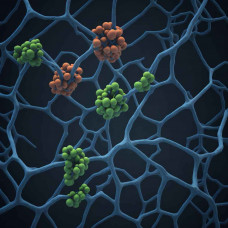High molecular weight organic substances consisting of alpha-amino acids linked by a peptide chain. In living organisms, the amino acid composition of proteins is determined by the genetic code, and 20 standard amino acids are used in most synthesis. Their many combinations result in a wide variety of properties in protein molecules. In addition, the amino acids within a protein are often subject to post-translational modifications, which can occur both before the protein begins to carry out its function and during its 'work' in the cell. In living organisms, several protein molecules often form complexes, such as the photosynthetic complex.
The functions of proteins in the cells of living organisms are more diverse than those of other biopolymers - polysaccharides and DNA. For example, enzyme proteins catalyse biochemical reactions and play an important role in metabolism. Some proteins have structural or mechanical functions, forming the cytoskeleton that supports the shape of cells. Proteins also play an important role in cell signalling systems, the immune response and the cell cycle.
Proteins
Tags: Proteins



